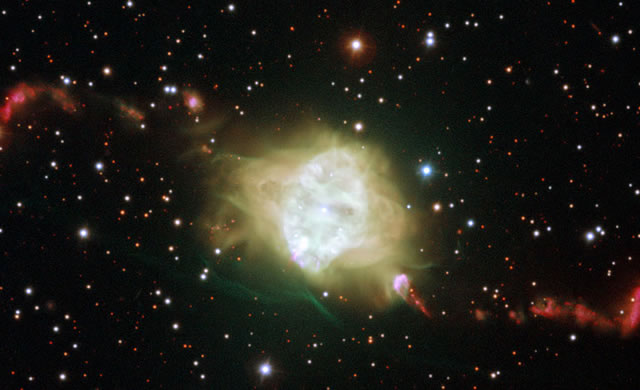
Una strana coppia di stelle anziane scolpisce una forma spettacolare in una nebulosa planetaria
Gli astronomi, utilizzando il VLT (Very Large Telescope) dell’ESO, hanno scoperto una coppia di stelle in orbita una intorno all’altra al centro di uno dei più notevoli esempi di nebulosa planetaria. Il nuovo risultato conferma una teoria molto discussa su che cosa controlli l’aspetto spettacolare e simmetrico del materiale lanciato nello spazio. I risultati sono pubblicati nel numero del 9 novembre 2012 della rivista Science.
Le nebulose planetarie sono gusci di gas incandescente intorno a nane bianche – stelle come il Sole, negli stadi finali di vita. Fleming 1 è un bellissimo esempio, con due getti sorprendentemente simmetrici che si intrecciano in nodi e curve. Si trova nella costellazione australe del Centauro e fu scoperta poco più di un secolo fa da Williamina Fleming, una ex-cameriera assunta dall’Osservatorio dell’Harvard College dopo aver dimostrato attitudini per l’Astronomia. Gli astronomi hanno discusso a lungo su come si possano produrre tali getti simmetrici, ma non è stato mai raggiunto alcun accordo. Ora, un’equipe di ricercatori guidata da Henri Boffin {ESO, Cile) ha combinato nuove osservazioni del VLT (Very Large Telescope) di Fleming 1 con modelli numerici esistenti per spiegare in dettaglio per la prima volta come si possono creare queste forme bizzarre. L’equipe ha usato il VLT dell’ESO per studiare la luce proveniente dalla stella centrale. Hanno trovato che probabilmente Fleming 1 ospita non una ma due nane bianche al centro, in orbita l’una intorno all’altra ogni 1,2 giorni circa. Anche se le stelle binarie sono già state trovate all’interno delle nebulose planetarie, sistemi con due nane bianche sono molto rari.
“L’origine delle belle e intricate forme di Fleming 1 e di oggetti analoghi è stata controversa per molti decenni”, dice Henri Boffin. “Gli astronomi avevano già suggerito in precedenza la presenza di una stella binaria, ma si pensava che in questo caso la coppia fosse molto larga, con un periodo orbitale di decine di anni o più. Grazie ai nostri modelli e alle osservazioni, che ci hanno permesso di esaminare questo sistema singolare in gran dettaglio e guardare proprio nel cuore della nebulosa, abbiamo scoperto che la coppia è qualche migliaio di volte più stretta di quello che si pensava”.
Fonte/Leggi tutto → ESO.org
Odd pair of aging stars sculpt spectacular shape of planetary nebula
Astronomers using ESO’s Very Large Telescope have discovered a pair of stars orbiting each other at the centre of one of the most remarkable examples of a planetary nebula. The new result confirms a long-debated theory about what controls the spectacular and symmetric appearance of the material flung out into space. The results are published in the 9 November 2012 issue of the journal Science.
Planetary nebulae are glowing shells of gas around white dwarfs — Sun-like stars in the final stages of their lives. Fleming 1 is a beautiful example that has strikingly symmetric jets that weave into knotty, curved patterns. It is located in the southern constellation of Centaurus (The Centaur) and was discovered just over a century ago by Williamina Fleming, a former maid who was hired by Harvard College Observatory after showing an aptitude for astronomy. Astronomers have long debated how these symmetric jets could be created, but no consensus has been reached. Now, a research team led by Henri Boffin (ESO, Chile) has combined new Very Large Telescope (VLT) observations of Fleming 1 with existing computer modelling to explain in detail for the first time how these bizarre shapes came about. The team used ESO’s VLT to study the light coming from the central star. They found that Fleming 1 is likely to have not one but two white dwarfs at its centre, circling each other every 1.2 days. Although binary stars have been found at the hearts of planetary nebulae before, systems with two white dwarfs orbiting each other are very rare.
“The origin of the beautiful and intricate shapes of Fleming 1 and similar objects has been controversial for many decades,” says Henri Boffin. “Astronomers have suggested a binary star before, but it was always thought that in this case the pair would be well separated, with an orbital period of tens of years or longer. Thanks to our models and observations, which let us examine this unusual system in great detail and peer right into the heart of the nebula, we found the pair to be several thousand times closer.”
Source/Continue reading → ESO.org






















Pingback: Vita Extraterrestre potrebbe comunemente trovarsi intorno a stelle binarie – Extraterrestrial Life May be Common Around Binary Stars | DENEB Official ©